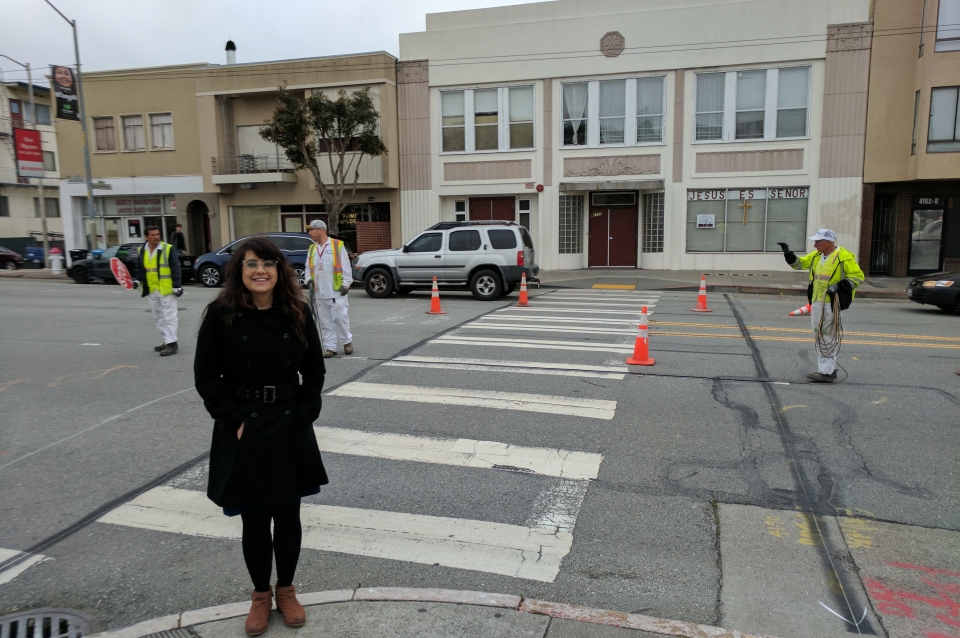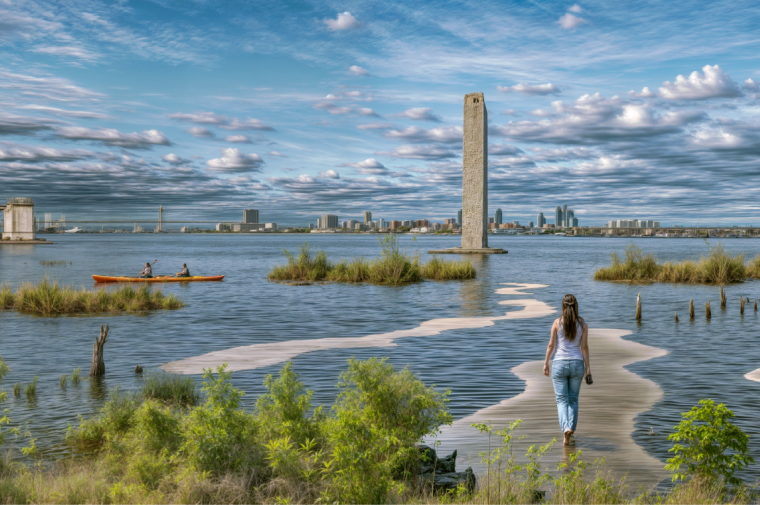December 8, 2017
Stuart Weitzman School of Design
102 Meyerson Hall
210 South 34th Street
Philadelphia, PA 19104
Get the latest Weitzman news in your Inbox
Media Contact
Michael Grant
mrgrant@design.upenn.edu
215.898.2539
Shayda Haghgoo (MCP’16) works for the City and County of San Francisco Municipal Transportation Agency (SFMTA) as a Transportation Planner II. Haghgoo’s work focuses on traffic calming, bicycle and pedestrian planning, and school area safety programs. She received a Bachelor of Science in Geography/Environmental Studies from the University of California, Los Angeles before coming to Penn.
What do you miss most about your time at PennDesign?
Watching the leaves change, appreciating the silence of snowfall, or witnessing flowers blossom into spring, I miss watching the seasons pass on Penn’s campus.
What does a typical day as Shayda look like?
It’s a very exciting and busy time to be in pedestrian and bicycle planning! The projects I'm on vary significantly in terms of neighborhoods, scale, and scope and my duties never focus on just one type of task. Luckily, my time at PennDesign really helped me prepare for the variety of work required to “complete” a street. On a typical day at the office I search for traffic collision patterns in GIS, debrief senior management and district supervisors on project details and timeline, present project background and next steps to community interest groups like the bicycle coalition or the hotel council, and finish up my day riding down a bike lane evaluating the safety impacts of newly installed delineators. Outside of work you can catch me drinking wine with my boyfriend and roommates as we people-watch from our stoop on Valencia Street, or attempting to practice martial arts at the dojo a couple blocks away.
What’s been your favorite professional project so far?
My favorite projects so far are mostly located in and around the Tenderloin neighborhood of San Francisco, one of which is the 6th Street Pedestrian Safety project. This project is a pretty ambitious undertaking driven by the City’s Vision Zero initiative: we are proposing to reconfigure a high traffic volume corridor located in downtown San Francisco that deltas into a freeway.
6th Street has been described as a hot spot for traffic collisions in the city, so the plan involves an assortment of improvements that we hope will improve pedestrian visibility and safety. The proposed improvements involve decreasing the number of traffic lanes in the right-of-way to allow for widened sidewalks, bulb-outs, and traffic signals at unprotected intersections. Some may describe this as a “road diet.” Though I’ve been advocating for our team to refrain from using that term as I believe it has a negative connotation. Los Angeles is currently facing a lot of backlash against its road diet attempts, like along Playa del Rey, which have led to anti-road diet political factions and even efforts to recall the council member who championed the aforementioned project. Also, who enjoys being told that they need a diet?
This project is my favorite because, depending on who you're talking to and what mode they use, you will get a very different and impassioned answer to the question, “Who is the street for?” Attempting to answer that question within the context of the Tenderloin neighborhood has been an eye-opening experience. Many of the residents in this neighborhood are some of the most marginalized in San Francisco. Some may define the Tenderloin as a “seedy” and “sketchy” neighborhood that should be avoided, while others celebrate its ability to resist gentrification.
Some of the resistance to gentrification could be attributed to the dozens of Single Residency Occupancy housing developments. Described as the last form of public housing in San Francisco, these developments have withstood market forces through strong SRO protection laws. It will be very interesting to see how the neighborhood evolves as we continue to invest more resources into improving its streets.
What was the best advice you’ve received and who was it from?
Get some sleep! From [department staff members] Kate Daniel, Roslynne Carter, and most of the Master of City Planning Class of 2016
If you could go backward or forward in time, what era would you choose and why?
I would like to imagine Barack Obama was channeling city planners when he said, in his 2009 healthcare speech, “We did not come to fear the future. We came here to shape it.”
Despite the current state of political affairs and the present and anticipated effects of climate change, I am very optimistic about the future. My optimism stems from the tenacity and ambition of my coworkers at SFMTA and the creative ideas introduced to me during my time at Penn.
I wish I could go at least 100 years into the future, so I can get answers to the following questions:
-
How have new and expanded ways of getting around like bike share, autonomous vehicles, and high-speed rail influenced land use and curb space?
-
Which mode of transportation proves to be most resilient to economic and environmental forces? (Ferries are underrated!)
-
Did California end up completing that high speed rail project?
What’s your favorite place in Philly?
I really loved walking out of the 15th Street station in Center City only to be confronted by skyscrapers surrounding the old, majestic masonry building that is City Hall. I also have yet to find a dance venue that rivals The Dolphin.
Favorite book or movie about art/design?
I was first introduced to the movie Blade Runner by Professor Landis during an Urban Planning Theory class. It is now one of my favorite movies of all time. Though they are arguably dystopian, I think Blade Runner and Blade Runner 2049 serve as great examples on how to visually represent the future of a city.
Who’s had the most influence on your work?
I really believe that I wouldn’t be where I am today if Kate Daniel hadn’t helped me push through some really tough times at Penn. Thanks, Kate!
Who’s on your current playlist?
Music: Nujabes, Childish Gambino, Kendrick Lamar, Solange, Sampha, Prince, Tribe Called Quest
Podcasts: All of the Crooked Media podcasts (Pod Save America, Pod Save the People, Majority 54, etc.), A Piece of Work, Black on the Air with Larry Wilmore, Car Talk, The Nod
Design hero, living or dead?
I recently came across a map of San Francisco as proposed by Daniel Burnham. He proposed this map (right) to the Board of Supervisors just before the 1906 earthquake. I think the City Beautiful concept could have really worked in San Francisco. I imagine the diagonal tree-lined boulevards would be great neighborhood connectors and street favorites to walk or bike along.
Pretzel or cheesesteak?
Shake Shack
Paris or London?
London! My first time visiting there was to stay with Kristiina Yang, a fellow alumna. Shout out to Stiin! I loved seeing what the city has to offer from the front seat of a double decker bus and waltzing into museums for free. The food wasn’t as bad as they say either, especially when it comes to Indian food! I’m drooling just thinking about that lamb vindaloo.


 Expand Image
Expand Image

